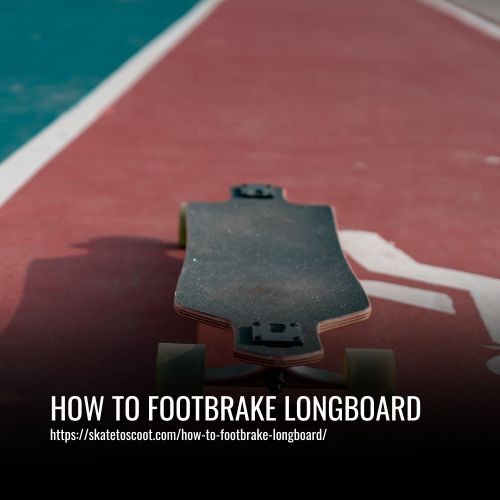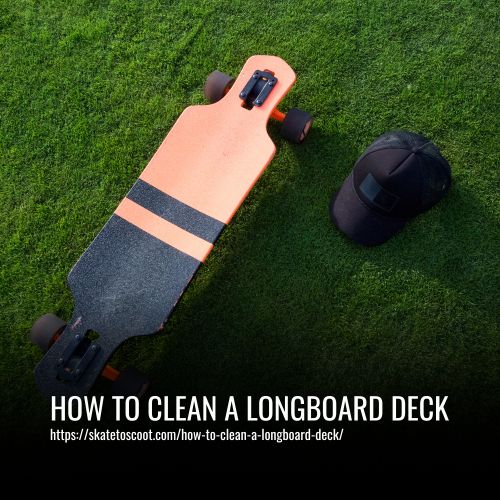As an Amazon Associate we earn from qualifying purchases.
Are you a beginner longboarder looking to learn an essential skill? Or maybe you’re an experienced rider looking to expand your repertoire of tricks? Either way, learning how to footbrake on a longboard is a must-know technique.
Footbraking is a fundamental skill that allows you to control your speed and come to a smooth stop without relying solely on your hands or sliding. It’s a versatile and practical skill that every longboarder should have in their arsenal.
In this article, I’ll guide you through the steps of how to footbrake on a longboard, breaking down the technique and offering some tips and tricks to help you master this essential skill. So, grab your board and let’s get rolling!

How to Footbrake on a Longboard: A Step-by-Step Guide
Foot braking is a fundamental skill that every longboard rider should master. It allows you to come to a controlled stop and is particularly useful when riding at moderate speeds or navigating through crowded areas. In this guide, we’ll cover the essential steps to perform a footbrake on your longboard.
1. Position yourself:
- Place your leading foot in front of the bolts and your rear foot comfortably on the board.
- Start by pushing off and finding your balance on your leading foot.
2. Prepare for the footbrake:
- Lower your brake foot either parallel to your leading foot or slightly forward.
- Avoid extending your legs too much to prevent losing balance, especially at high speeds.
- Gradually shift your weight onto your brake foot, focusing on maintaining a confident one-foot balance.
3. Engage the footbrake:
- Squat down slightly and lower your brake foot until it touches the pavement.
- Use both your heel and the middle of your foot as the primary braking surface to maximize friction and control.
- Avoid catching pavement cracks with your toe by slightly raising it when braking, reducing the risk of a sudden jolt.
4. Control your speed:
- Apply pressure gradually to your brake foot, gradually reducing your speed.
- Be mindful of your foot position and only lift your toe, keeping the rest of your foot flat on the pavement.
- Experiment with the amount of pressure needed to achieve your desired braking effect, practicing on flat ground initially before attempting steeper hills.
What is foot braking?
Footbraking is an essential skill for any longboarder, allowing riders to control their speed and safely come to a stop without the need for slide gloves or other advanced sliding techniques. It involves using the back foot as a brake by dragging it on the ground to create friction and decrease speed.
Footbraking is commonly used when riding at moderate speeds, going down hills, or when navigating through crowded areas. It provides a straightforward and reliable method for slowing down or stopping, making it an important skill for riders of all levels.
By mastering footbraking, longboarders can have increased control over their boards and gain confidence in their ability to ride in various terrains and situations.
Why Should You Learn How To Footbrake Longboard?
Learning how to footbrake on a longboard is an essential skill for riders of all levels. Footbraking allows you to maintain control and safely slow down or come to a complete stop while riding at various speeds.
One of the main benefits of footbraking is safety. By being able to slow down or stop quickly, you can avoid accidents and reduce the risk of road rash. This is especially important when riding in traffic or crowded areas where unexpected obstacles may appear.
Another advantage of footbraking is the ability to control your speed on downhill descents. Whether riding on flat ground or steep hills, being able to regulate your speed gives you an extra level of confidence and ensures a smooth and enjoyable ride.
Footbraking also helps in improving overall board control. By shifting your body weight and using your rear foot to apply pressure on the ground at a slide, you can develop a better understanding of balance and stability. This skill translates to other maneuvers, such as slides and turns.
How to Footbrake
Learning how to footbrake is an essential skill for every longboarder, from beginners to professionals. Footbraking allows you to slow down and stop quickly, providing you with control and safety on your board. Here’s a step-by-step guide on how to footbrake effectively:
Get Rolling
To footbrake on a longboard, start by getting rolling at a comfortable pace, around a jogging or running speed. Assume your normal stance on the board, with your rear foot positioned on the tail and your toes on the edge for stability. As you approach the point where you want to stop, shift your body weight gradually towards your rear foot to create extra stability. Once you’re ready to footbrake, place your rear foot flat on the ground, slightly raising your heel. Apply pressure by dragging your foot across the ground to slow down. Experiment with the amount of pressure applied to achieve the desired speed reduction, making sure not to apply too much pressure to avoid sudden stops and potential falls. Additionally, practice rotating your hips and shoulders in the opposite direction of your footbraking foot for better control and stability. Remember to always wear protective gear, such as knee pads, elbow pads, and a helmet, to ensure your safety while footbraking.
Set Up Your Feet
To set yourself up for footbraking on a longboard, it’s important to position your feet correctly. Start by turning your front foot slightly so that it’s pointing more along the length of the board rather than sideways. This will allow you to face forward with your body while footbraking.
Setting up your feet for footbraking is similar to the position you have when pushing off on the board. By aligning your front foot along the length of the board, you create a solid foundation for footbraking and ensure you’re in the right position to apply pressure on the ground.
Having your feet properly set up for footbraking is crucial for maintaining proper balance and control during the braking process. It allows you to have a more stable and controlled footbraking technique, helping you slow down or come to a complete stop efficiently and safely.
Remember to always wear the appropriate protective gear such as slide gloves, knee pads, and elbow pads when footbraking to reduce the risk of injuries like road rash. Building your confidence and comfort with footbraking will provide you with an essential skill for controlling your speed on a longboard.
Lift Your Back Foot
To footbrake on a longboard, one of the essential steps is to lift your back foot off the deck. This action helps initiate the braking process and maintain balance while slowing down or coming to a complete stop. When performing this movement, it is important to take your time and not rush.
Start by bending your front knee and shifting your weight forward. By doing this, you create a stable base and maintain control throughout the braking maneuver. As you bend your knee, gradually lift your back foot off the deck of the board. This action transfers your weight towards the front foot, increasing stability and control.
It may be tempting to rush this step, but it is crucial to stay relaxed and keep a smooth motion. By maintaining a relaxed posture and not hurrying, you ensure that you have full control over the braking process. This technique allows you to footbrake in a controlled and efficient manner, giving you the confidence to slow down or stop safely when needed.
Remember, lifting your back foot is just one component of footbraking, and it works in conjunction with other techniques such as applying pressure on the ground and using your body weight to control speed. Practice this skill regularly to become proficient in footbraking and ride with confidence.
Skim your braking foot
Skimming your braking foot is an essential technique when footbraking on a longboard. To execute this maneuver, start by bending your front knee as you ride. As you approach the desired stopping point, position your back foot so that it is parallel to the length of the board.
Next, gradually skim your back foot along the road surface. It’s important to maintain a smooth and even contact with the road. Start with minimal pressure on your braking foot and gradually increase it until you feel a solid and consistent contact across your foot.
By skimming your foot along the road, you create friction that helps slow down your board. This technique allows for a controlled and gradual deceleration, providing you with the ability to adjust your speed as needed. Remember to stay relaxed and maintain proper body posture throughout the footbraking process.
Skimming your braking foot is an effective and efficient way to slow down or stop on a longboard. It provides you with the control and stability necessary for a safe and confident ride. Practice this technique regularly to improve your footbraking skills and enhance your overall riding experience.
Lean back and brake
To execute a footbrake on your longboard, you must lean back and apply more weight onto your braking foot. This weight transfer will effectively slow you down at a quicker pace. However, it’s crucial not to overdo this leaning motion, particularly when you’re traveling at higher speeds. Overdoing it can compromise your stability. To maintain balance, utilize your arms as a counterbalance if necessary. Additionally, for extra stability, you can lock your ankle against the rail of your longboard.
When performing the footbrake, ensure that you maintain gradual and even contact between your foot and the road surface. This technique will help you control your deceleration and provide the ability to adjust your speed as needed. As you skim your foot along the road, try varying the weight distribution across your foot, from your toes to your heel. This variation will help prevent excessive wear on a specific part of your shoe. Remember to stay relaxed and maintain proper body posture throughout the footbraking process.
Next Steps
- Practice Regularly: To become proficient at footbraking, it is important to practice regularly. Set aside dedicated time to work on your footbraking technique and build muscle memory. The more you practice, the more comfortable and confident you will become.
- Experiment with Different Speeds: Start by practicing footbraking at slow speeds on flat ground. Once you feel comfortable, gradually increase your speed and practice on slightly steeper hills. This will help you gauge how much pressure to apply and how to control your speed effectively in different situations.
- Explore Other Brake Techniques: While footbraking is an essential skill, it’s beneficial to explore other brake techniques as well. Slide gloves are commonly used for hands-down slides and are especially useful at higher speeds. Familiarize yourself with different techniques like the Coleman slide or power slides to add more options to your braking arsenal.
- Build Confidence Gradually: It’s important to build your confidence in footbraking gradually. As you become comfortable with the technique and gain more experience, you can start incorporating footbraking into your rides, especially when navigating crowded areas or when you need to come to a quick, controlled stop.
Remember, footbraking is an essential skill for any longboard rider, but it’s important to practice, experiment, and prioritize safety to become a proficient and confident footbraker. So keep practicing and improving your footbraking technique to ride with control and confidence.
Essential Gear for Footbraking
When it comes to footbraking on a longboard, having the right gear is essential. The following equipment will not only enhance your safety but also maximize your control and comfort while footbraking.
- Slide Gloves: Slide gloves are a crucial piece of gear for footbraking. These gloves feature durable palm pucks that allow you to place your hands on the ground during a slide, providing extra stability and control. They protect your hands from road rash and offer a reliable grip, giving you the confidence to execute smooth and controlled footbrakes.
- Knee Pads: While footbraking primarily relies on using your feet and hands, knee pads are still important. They provide an extra layer of protection in case of a fall or unexpected obstacles. Knee pads also give you the freedom to comfortably shift your body weight during footbraking, making it easier to maintain balance and control.
- Elbow Pads: Similar to knee pads, elbow pads are beneficial in case of a fall. They protect your elbows from injuries and abrasions, ensuring that you can confidently place your hands on the ground for stability during footbraking.
Safety Considerations When Footbraking
When footbraking while longboarding, it is essential to prioritize safety to prevent accidents and minimize the risk of injuries. Here are some important safety considerations to keep in mind:
- Protective Gear: Wearing the right protective gear is crucial when footbraking. A helmet is essential to protect your head from any potential impact in case of a fall. Knee pads and elbow pads provide an extra layer of protection for your joints, minimizing the risk of injuries such as bruises, scrapes, or fractures.
- Proper Technique: It is important to learn and practice the correct footbraking technique to maintain control and stability. This includes maintaining a comfortable foot position and spreading your weight evenly on your board. Make sure to practice on flat ground before attempting footbraking on steeper hills.
- Gradual Speed Reduction: When footbraking, it is recommended to gradually reduce your speed rather than fully stopping abruptly. This allows for better control and reduces the risk of losing balance or sliding out.
- Road Conditions: Be aware of the road conditions when footbraking. Smooth and dry pavement provides better traction, making it easier to execute a footbrake. Avoid roads with loose gravel, potholes, or other obstacles that may hinder your braking technique.
Conclusion:
Mastering the art of the footbrake on a longboard is not only a practical skill, but it’s also a thrilling way to control your speed and navigate any terrain. So, grab your longboard, practice those footbrake techniques, and get ready to feel the wind in your hair as you confidently cruise down the streets.
Remember, with a little practice and determination, you’ll be foot-breaking like a pro in no time!
Amazon and the Amazon logo are trademarks of Amazon.com, Inc, or its affiliates.


